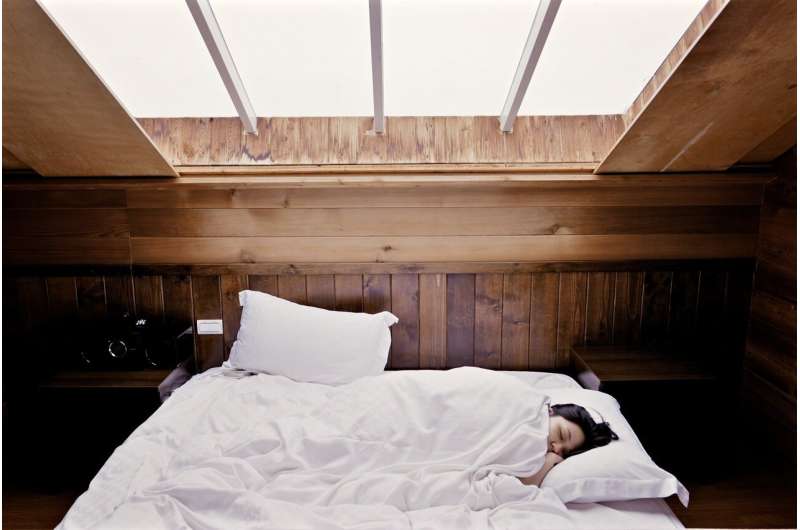
Research shows adults need seven to nine hours of sleep each night for optimal health, and children need more.
But what’s happening during those hours that’s so important, and what’s the danger of cutting sleep short?
A growing body of research shows getting little or poor sleep doesn’t just make people feel tired the next day—it places them at higher risk for heart attacks and early death, along with cognitive decline, dementia, diabetes, high blood pressure, obesity, depression and other chronic health conditions.
There’s so much evidence linking poor sleep to poor health that the American Heart Association last year added sleep duration to its list of critical components for optimizing heart and brain health.
Yet about 1 in 3 adults don’t get enough. Experts say shaving a couple of hours robs the brain of time it needs to perform vital functions.
“There’s lots of stuff that happens during sleep,” said Dr. Michael Grandner, director of the Sleep and Health Research Program and an associate professor in the department of psychiatry at the University of Arizona College of Medicine in Tucson. “When your body doesn’t have enough time to do the things it needs to do, it won’t do them in an optimal way.”
Grandner co-wrote the 2022 advisory that added sleep duration to AHA’s list of key measures for good cardiovascular health, known as Life’s Essential 8.
While researchers are still investigating how suboptimal sleep affects the mechanisms linked to cardiovascular health, Grandner said much is known about other functions that occur during the major stages of sleep.
The first few hours of sleep are the deepest, he said. It’s during this time that the body performs tissue growth and repair, allowing healing and restoration to occur. It’s also the time when the brain clears away stuff it doesn’t need, making room for the stuff it does need. The space between neurons gets a little wider, allowing the brain to flush out waste products.
“This is synaptic pruning, when the brain filters out the junk experiences of the day, the stuff you don’t need to learn from long-term,” Grandner said.
Deep sleep is followed by rapid eye movement, also known as REM sleep, which is lighter. The brain is active during this stage, but the body is immobile. This is when dreams and nightmares occur, Grandner said. The body actually cycles through REM and non-REM cycles several times, with increasingly longer periods in REM sleep as the night goes on.
“If you cut your sleep hours short, most of what you’ve deprived yourself of is REM sleep,” he said. That can interfere with learning, memory and mood, which are all regulated during this stage of sleep. Studies show people who are deprived of REM sleep have trouble remembering things they learned before falling asleep.
The last stage of sleep is when more mental recovery and healing occur, Grandner said. But it’s also when the body finishes the physical recovery work begun during deep sleep.
Grandner likened it to power washing a driveway and then re-sealing it to preserve it for continued good use. “The first stage of sleep is when the power washing occurs. The last stage is when resealing occurs. Waking up before the last stage of work cuts corners that can cause problems in the long-term health of the body and brain,” he said.
Children and teenagers need more hours because they are still growing, and sleep is when growth hormones are released, Grandner said. The AHA recommends children ages five and younger get 10 to 16 hours of sleep each day; those six to 12 get between nine and 12 hours; and teens get eight to 10 hours.
Luckily, there are steps people can take to get a better night’s sleep, said Dayna Johnson, an assistant professor and sleep epidemiologist at Emory University’s Rollins School of Public Health in Atlanta. “Engaging in good sleep hygiene or sleep practices can help to improve sleep. It is important to foster a good sleep environment.”
This includes having a consistent bedtime and bedtime routine, sleeping in a dark, quiet room at a comfortable temperature and keeping electronic devices, such as televisions, phones and computers, out of the bedroom.
But there are other factors that can affect sleep that may be beyond a person’s control, Johnson said. And that’s where sleep health disparities creep in.
For example, lower-income neighborhoods have more noise and light, which can disrupt sleep. Neighborhoods with higher levels of air pollution are associated with greater inflammation, which can lead to sleep apnea, making it difficult to get a good night’s rest. And people who work minimum-wage jobs and therefore work multiple jobs or jobs with rotating shifts may find it harder to develop regular sleep patterns, she said.
Johnson, who studies sleep health disparities, led a 2019 review of a large body of research summarizing racial and ethnic differences in sleep duration and quality. It found, for example, that Black, Hispanic and Chinese adults were disproportionately more likely to get less than six hours of sleep each night and more likely to report poor sleep quality.
As it does in cardiovascular health, structural racism may also play a role. Structural racism has been shown to affect neighborhood environments, leading to problems such as poorer air quality and housing. Additionally, Black people with higher education, higher-paying jobs, and reside in better neighborhoods have been shown to have poorer sleep health than their white peers, Johnson said.
“The determinants of sleep disparities are multifactorial, and the worse sleep among higher SES Black adults may be due to increased exposure to racism/stress from being a minority in the workplace or neighborhood,” she said. “There are many reasons someone may have poor sleep.”
Laura Williamson, American Heart Association

